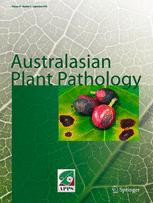Ver ítem
- xmlui.general.dspace_homeCentros e Institutos de InvestigaciónCIAP. Centro de Investigaciones AgropecuariasInstituto de Patología VegetalArtículos científicosxmlui.ArtifactBrowser.ItemViewer.trail
- Inicio
- Centros e Institutos de Investigación
- CIAP. Centro de Investigaciones Agropecuarias
- Instituto de Patología Vegetal
- Artículos científicos
- Ver ítem
Qualitative and quantitative factors affecting the relationship between Canola leaf spot epidemic and stem base canker (Leptosphaeria maculans) in Argentina
Resumen
Stem base canker caused by Leptosphaeria maculans (SBC) has been reported to affect canola production worldwide. Ascospores infections produce leaf spots (LS) in early vegetative stages. From these initial spots, the fungus grows towards the stem crown and may cause SBC, lodging and premature ripening at maturity. Growth stage at LS presence, cultivar resistance and environment conditions are factors associated with SBC severity. Since there are no
[ver mas...]
Stem base canker caused by Leptosphaeria maculans (SBC) has been reported to affect canola production worldwide. Ascospores infections produce leaf spots (LS) in early vegetative stages. From these initial spots, the fungus grows towards the stem crown and may cause SBC, lodging and premature ripening at maturity. Growth stage at LS presence, cultivar resistance and environment conditions are factors associated with SBC severity. Since there are no studies that associate the LS epidemic with SBC for the Argentine cropping conditions we performed two experiments to address this essential knowledge for SBC management. In 2010, plants of four cultivars (varying in their level of resistance to LS and SBC) ranging from cotyledon stage up to 9 developed leaves were transplanted to a field where artificial inoculation was carried out by spreading infected canola stubble from the previous year. The probability of SBC occurrence depended on the interaction between cultivar resistance level and the number of developed leaves at the moment of LS detection. Based on these results, in 2011 plots of the most susceptible cultivar (Nexera 8450) received different fungicide protection treatments (azoxystrobin or propiconazole and timing of spraying) and were exposed to natural L. maculans infections. We observed that the maximum incidence of LS up to 8th developed leaf best correlated with SBC severity at maturity and a linear regression was fitted to model the relationship between these two variables.
[Cerrar]

Autor
Edwards Molina, Juan Pablo;
Escande, Alberto;
Cendoya, María Gabriela;
Quiroz, Facundo Jose;
Fuente
Australasian plant pathology 46 (5) : 453–461. (September 2017)
Fecha
2017-09
Editorial
Springer
ISSN
0815-3191
1448-6032 (Online)
1448-6032 (Online)
Formato
pdf
Tipo de documento
artículo
Palabras Claves
Derechos de acceso
Embargado
 Excepto donde se diga explicitamente, este item se publica bajo la siguiente descripción: Creative Commons Attribution-NonCommercial-ShareAlike 2.5 Unported (CC BY-NC-SA 2.5)
Excepto donde se diga explicitamente, este item se publica bajo la siguiente descripción: Creative Commons Attribution-NonCommercial-ShareAlike 2.5 Unported (CC BY-NC-SA 2.5)

